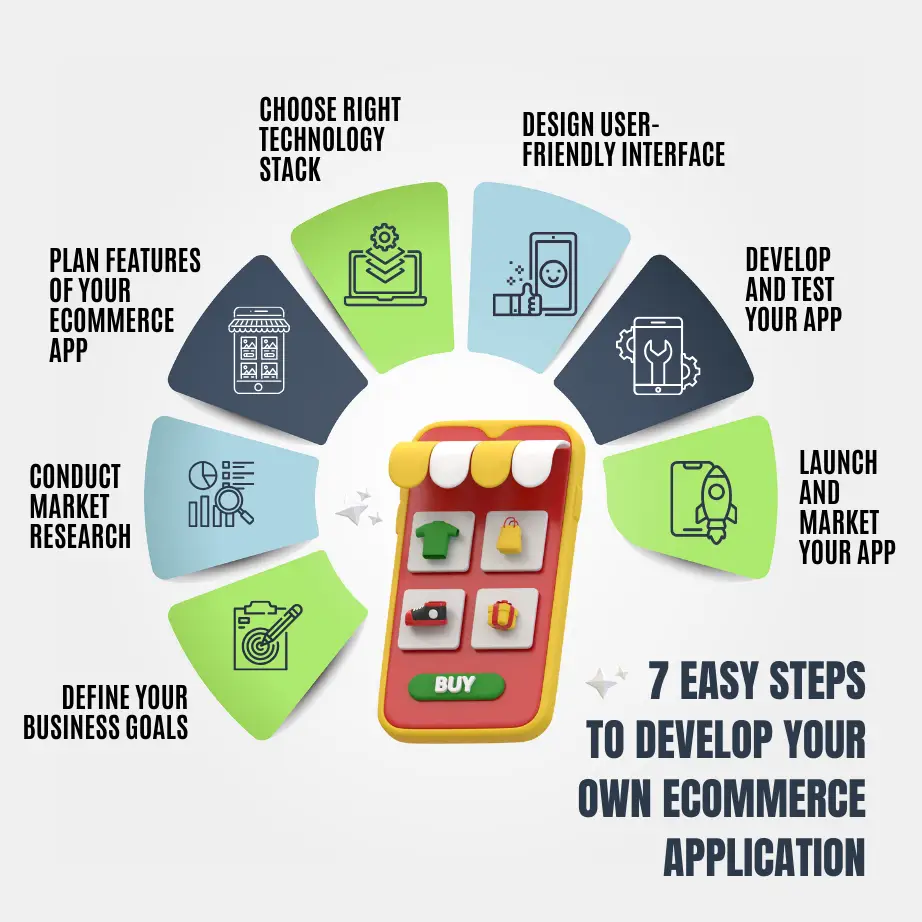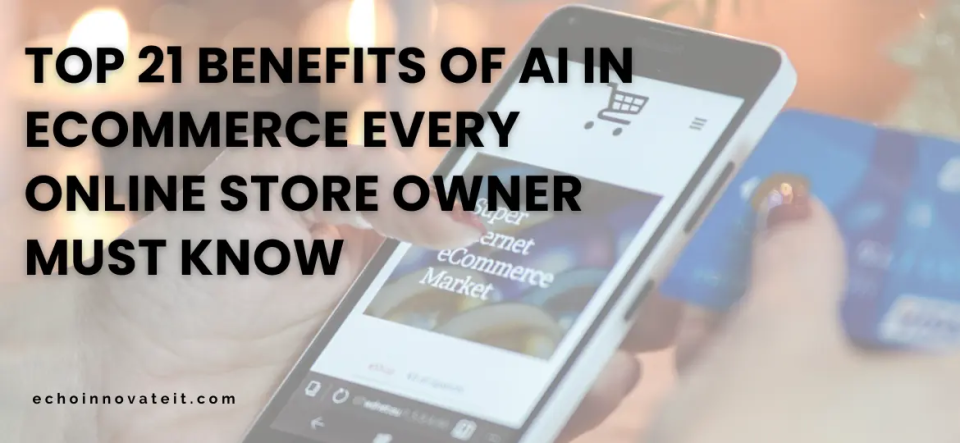The future of retail is shopping experiences that are more engaging, more personalized, and more convenient than ever before. Technology will play a critical role in making that happen.”
~ Satya Nadella, CEO of Microsoft
E-commerce applications in the upcoming years will focus more on creating excellent customer experiences, utilizing AI and automation, and exploring new business models. And so we can’t agree more with the above-written quote and its fairly stated prediction. If you want to ace today’s cutthroat shopping app industry and create a more extensive customer base like Amazon, eBay, Walmart, and Shopify…this blog post is just for you!
The e-commerce app sector is expanding in 2024, there will be more than 2.7 billion online buyers worldwide, expected to rise to 2.77 billion by 2025. Online retail sales are predicted to exceed $6.3 trillion by 2024, accounting for 20.1% of all retail purchases. This percentage is expected to increase to 22.6% by 2027. In simple terms, investing in an eCommerce app can be a smart move to promote business growth, improve customer satisfaction, and gain a competitive advantage in the digital marketplace.
What is an eCommerce Application?
An eCommerce application is simply a digital store that enables businesses to sell products or services directly to customers via mobile devices or web browsers. It is a software app platform that facilitates online shopping by offering features such as product browsing, shopping cart functionality, secure payment processing, and order tracking.
Transactions in the eCommerce market are typically categorized as business-to-consumer (B2C), consumer-to-consumer (C2C), or business-to-business. eCommerce apps are designed around the buyer-seller connection. These categories are used to categorize the numerous sorts of eCommerce app experiences available in the eCommerce business, as well as the various e-commerce applications.
Why should you Invest in eCommerce App Development
Investing in eCommerce app development is critical for firms that want to succeed in today’s digital market. With the growing reliance on smartphones, a specialized app can significantly increase your brand’s visibility and revenue. Here are some reasons why you should develop an e-commerce app in 2024:
Also Check:
Seamless and Convenient Shopping Experience For Customers
Customers benefit from an eCommerce app’s seamless and convenient buying experience. They may easily browse products, make purchases, and track orders from anywhere and at any time. This convenience increases client loyalty and encourages repeat purchases.
Unparalleled Opportunities For Personalization
Apps provide unique chances for personalization. Collecting user data allows you to adjust product recommendations, discounts, and notifications, resulting in a more engaging and relevant shopping experience. This level of customization can significantly boost conversion rates.
Enhances Brand Visibility and Reach
An app increases brand awareness and reach. It provides direct customer communication, allowing you to circumvent competitors and establish a more substantial brand presence. Push notifications can notify customers about new items, sales, or exclusive offers, keeping your brand front of mind.
Provide Valuable Customer Insights
eCommerce apps offer significant customer insights. Tracking user behavior within the app can provide helpful information about client preferences, purchasing patterns, and usage. This information can help you improve your product offers, marketing methods, and general business processes.
7 Easy Steps to Develop Your Own eCommerce Application

Developing an eCommerce application may appear complicated, but with a disciplined approach, it becomes manageable. Let’s divide the process into seven steps:
Step 1: Define your target audience and business goals
- Identify your target market: Who are you selling to? Understanding your clients will allow you to personalize your product offers and marketing techniques better.
- Establish explicit business objectives: What do you want to achieve with your eCommerce app? Is it boosting revenues, raising brand awareness, or enhancing consumer engagement?
Also Check:
Step 2: Conduct market research
- Analyze competitors: Investigate successful eCommerce apps in your niche. Determine their strengths and weaknesses.
- Identify the market trends: Keep up with eCommerce trends and consumer behavior. Validate your product idea. Collect feedback from potential customers to guarantee your product or service is in demand.
- Validate your product idea: Collect feedback from potential customers to guarantee that your product or service is in demand.
Step 3: Plan the Features for Your eCommerce App
- Essential elements include a product catalog, shopping cart, secure checkout, payment gateways, order tracking, and customer support.
- Value–added features: Add product reviews, wish lists, personalized recommendations, incentive programs, and social sharing.
- Prioritize characteristics: Begin with essential functionality and add more complicated features as your software matures.
Step 4: Choose the Right Technology Stack
- Ecommerce platform: Choose amongst Shopify, Magento, WooCommerce, and BigCommerce according to your budget, scalability, and feature requirements.
- Mobile app development: Based on your target audience and resources, design native apps (for iOS and Android), hybrid apps, or progressive web apps (PWAs).
- Payment gateways: Integrate secure payment methods like PayPal, Stripe, and Authorize.Net.
Step 5: Design User-Friendly Interface
- Create a visually appealing design: Ensure your app’s design and feel are consistent with your brand identity.
- Optimize for mobile: Create a responsive UI on all screen widths.
- Prioritize the user experience: Make the navigation simple for customers to find things.
Step 6: Develop and Test Your App
- Build the app: Create frontend and backend features depending on your design and technology stack.
- Conduct rigorous testing to discover and fix errors, guaranteeing a pleasant user experience.
- Performance optimization: Improve your app’s performance and responsiveness.
Step 7: Launch and Market Your App
- App Store submission: Prepare your app for submission to the Apple App Store and Google Play.
- Marketing strategy: Create a thorough marketing plan to attract clients and increase sales.
- Continuous improvement: Collect user feedback and iterate on your app to increase performance and satisfaction.
Key Features of an E-commerce Mobile App
Building a successful e-commerce mobile app requires essential features that enhance user experience and drive engagement. A well-developed e-commerce app should align with user expectations and provide a seamless shopping journey. Here are the key features to consider when developing an e-commerce mobile app:
1. Native User Experience
Users expect a familiar interface that aligns with their device’s platform. Whether you are working with iOS or Android, ensure your e-commerce app maintains consistent design elements, gestures, and functionalities. A smooth and intuitive user interface will enhance customer satisfaction and engagement.
2. Item Reviews and Ratings
Customer reviews influence purchasing decisions. An integrated review system in your e-commerce mobile app allows users to see feedback and ratings before buying a product. This feature helps build trust and encourages users to make informed choices.
3. Social Media Integration
Connecting your e-commerce application with social networks enhances user engagement. Shoppers can share product reviews, wishlist items, and recent purchases, creating organic promotions for your e-commerce store. Social integrations also simplify sign-ups and logins.
4. Wishlist and Favorites
A wishlist feature enables customers to save products for future purchases. This not only improves the shopping experience but also provides valuable insights into user preferences. E-commerce mobile apps can leverage wishlists for personalized recommendations and targeted promotions.
5. Seamless Checkout Process
An optimized checkout experience is crucial for reducing cart abandonment. Your e-commerce mobile app should offer features like address saving, auto-fill options, and one-click checkouts. The easier the process, the more likely users are to complete their purchases.
6. Multiple Payment Options
Offering diverse payment methods is essential for a global customer base. Your e-commerce app should support various payment gateways, including credit cards, digital wallets, and region-specific payment solutions, ensuring convenience for all users.
7. Push Notifications
Push notifications are an effective tool for keeping users engaged. Use them to notify customers about new arrivals, promotions, order updates, and wishlist discounts. A well-timed notification can drive repeat visits and increase conversions.
Building the Best E-commerce Mobile App
Partnering with an experienced e-commerce app development company ensures a feature-rich and scalable solution. Whether you want to build an e-commerce app from scratch or enhance an existing e-commerce platform, focusing on user-friendly design and seamless functionality is key. With the right approach, your e-commerce mobile app can compete with the best e-commerce platforms and online e-shopping solutions available today.
Cost of Developing an eCommerce App
The cost of creating an eCommerce app is highly varied and depends on several things. These include the app’s complexity, target platforms (iOS, Android, or both), design sophistication, and feature implementation. Simple software with little functionality could cost tens of thousands of dollars, whereas a complicated app with advanced features and a robust backend could easily cost hundreds or even millions.
The factors affecting its cost are app complexity, platform dependability (iOS or Android), design, features, development team, location, ongoing costs, etc. Additionally, recurring expenses like app store fees, hosting, maintenance, and marketing must be considered.
Conclusion
Building a successful eCommerce app in 2024 demands a deliberate approach that combines technical knowledge with a thorough grasp of consumer behavior. By following the seven steps mentioned in this article, you can establish a solid basis for your app’s development.
Ready to develop a powerful eCommerce application in 2024? With careful planning, execution, and a commitment to providing outstanding value, your eCommerce app may become an effective tool for increasing sales and developing a loyal client base. Echoinnovate IT is a top mobile app development company in USA. Reach out to us to hire our services.
FAQs
What are the first steps to building an eCommerce app?
Start with market research and define your target audience to ensure your app meets user needs.
How important is choosing the right platform for my eCommerce app?
It’s crucial; the right platform ensures scalability, security, and ease of use.
What features are essential for an eCommerce app in 2024?
Key features include a user-friendly interface, secure payment options, product management, and customer support.



